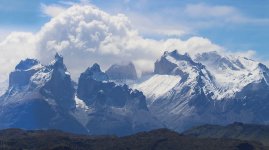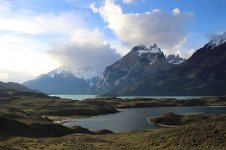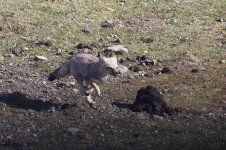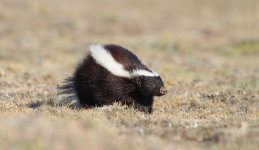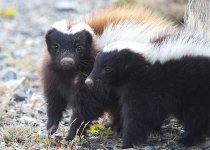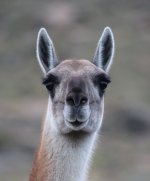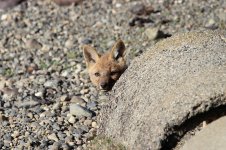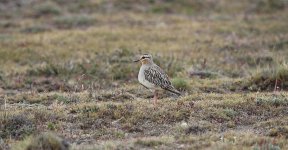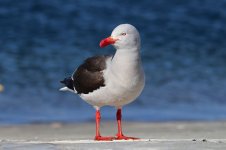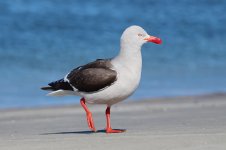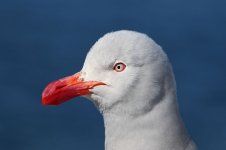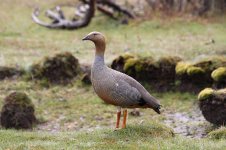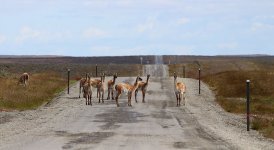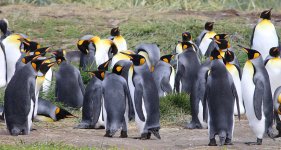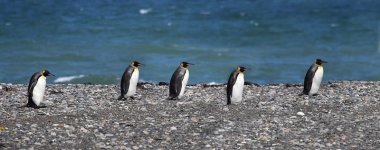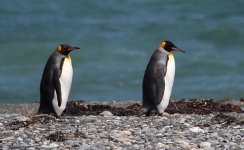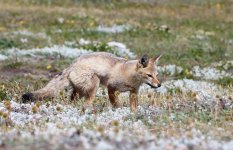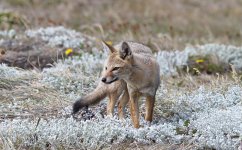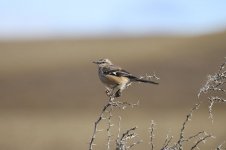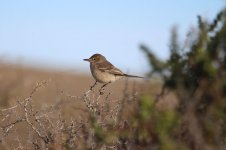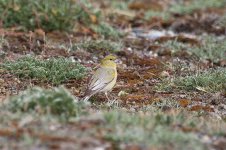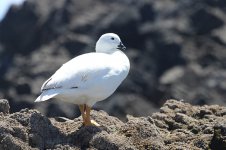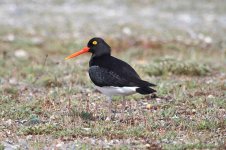
-
Welcome to BirdForum, the internet's largest birding community with thousands of members from all over the world. The forums are dedicated to wild birds, birding, binoculars and equipment and all that goes with it.
Please register for an account to take part in the discussions in the forum, post your pictures in the gallery and more.
You are using an out of date browser. It may not display this or other websites correctly.
You should upgrade or use an alternative browser.
You should upgrade or use an alternative browser.
Chile, Land of Condors and King Penguins (1 Viewer)
- Thread starter Jos Stratford
- Start date
More options
Who Replied?
21 December. Torres de Paine, Transit Road & Punta Delgada.
Back on the tracks of Torres de Paine at dawn, a quick look round for any further signs of Mountain Lion. Only gave it a couple of hours, then quit for a breakfast of sorts on the banks of the river near the night before's sighting – a pair of Spectacled Ducks on the river, Rufous-tailed Plantcutters in adjacent scrub, Black-chested Buzzard-Eagles and Andean Condor overhead. Added a few more birds such as Cordilleran Canastero and Buff-winged Cinclodes, then decided to cut and run, the new plan being to spend the entire day traversing the Patagonian grasslands en route for Ponta Delgada far to the east, a drive of 390 km.
Drove fairly quickly back to Puerto Natales and onward to the beginning of the gravel transit road 405. From there on, drove far more sedately, frequent stops to scan the grassland. Lesser Rheas again in abundance, so too Southern Caracaras and Least Seedsnipes, the latter including a small chick beside the road. Also a half dozen Chocolate-vented Tyrants, a pair of Dark-faced Ground-Tyrants, fifteen Common Miners, at least 18 Black-throated Finches and, highlight, no less than 22 Tawny-throated Dotterels, most in a single flock. Equally impressive though were the mammals – six species recorded on the transit, not just Gunacos (at least 300) and Brown Hares (minimum 40), but also three more Hog-nosed Skunks, one more Big Hairy Armadillo and, another cause for celebration, three South American Grey Foxes (one feeding at a carcass, one sleeping on a bank, one running across the grasslands). Even better, discovered three young Culpeo Foxes living in a culvert beneath the road.
Arrived in Punta Delgada in the early evening, no hotels in the area, so plonked the tent up aside an intertidal mudflat. Ended the day to three Cinereous Harriers, 20 or so Magellanic Oystercatchers, eight Two-banded Plovers and a whole host of other birds, washed down by hot dogs and coffee at a small cafe next to the ferry port for departures to Tierra del Fuego.
Back on the tracks of Torres de Paine at dawn, a quick look round for any further signs of Mountain Lion. Only gave it a couple of hours, then quit for a breakfast of sorts on the banks of the river near the night before's sighting – a pair of Spectacled Ducks on the river, Rufous-tailed Plantcutters in adjacent scrub, Black-chested Buzzard-Eagles and Andean Condor overhead. Added a few more birds such as Cordilleran Canastero and Buff-winged Cinclodes, then decided to cut and run, the new plan being to spend the entire day traversing the Patagonian grasslands en route for Ponta Delgada far to the east, a drive of 390 km.
Drove fairly quickly back to Puerto Natales and onward to the beginning of the gravel transit road 405. From there on, drove far more sedately, frequent stops to scan the grassland. Lesser Rheas again in abundance, so too Southern Caracaras and Least Seedsnipes, the latter including a small chick beside the road. Also a half dozen Chocolate-vented Tyrants, a pair of Dark-faced Ground-Tyrants, fifteen Common Miners, at least 18 Black-throated Finches and, highlight, no less than 22 Tawny-throated Dotterels, most in a single flock. Equally impressive though were the mammals – six species recorded on the transit, not just Gunacos (at least 300) and Brown Hares (minimum 40), but also three more Hog-nosed Skunks, one more Big Hairy Armadillo and, another cause for celebration, three South American Grey Foxes (one feeding at a carcass, one sleeping on a bank, one running across the grasslands). Even better, discovered three young Culpeo Foxes living in a culvert beneath the road.
Arrived in Punta Delgada in the early evening, no hotels in the area, so plonked the tent up aside an intertidal mudflat. Ended the day to three Cinereous Harriers, 20 or so Magellanic Oystercatchers, eight Two-banded Plovers and a whole host of other birds, washed down by hot dogs and coffee at a small cafe next to the ferry port for departures to Tierra del Fuego.
Last edited:

Jeff Hopkins
Just another...observer

Good memories. I loved Torres del Paine!
Keep it up Jos.
Keep it up Jos.
Alan henry
Well-known member

21 December. Torres de Paine, Transit Road & Punta Delgada.
Back on the tracks of Torres de Paine at dawn, a quick look round for any further signs of Mountain Lion. Only gave it a couple of hours, then quit for a breakfast of sorts on the banks of the river near the night before's sighting – a pair of Spectacled Ducks on the river, Rufous-tailed Plantcutters in adjacent scrub, Black-chested Buzzard-Eagles and Andean Condor overhead. Added a few more birds such as Cordilleran Canastero and Buff-winged Cinclodes, then decided to cut and run, the new plan being to spend the entire day traversing the Patagonian grasslands en route for Ponta Delgada far to the east, a drive of 390 km.
Drove fairly quickly back to Puerto Natales and onward to the beginning of the gravel transit road 405. From there on, drove far more sedately, frequent stops to scan the grassland. Lesser Rheas again in abundance, so too Southern Caracaras and Least Seedsnipes, the latter including a small chick beside the road. Also a half dozen Chestnut-vented Tyrants, a pair of Dark-faced Ground-Tyrants, fifteen Common Miners, at least 18 Black-throated Finches and, highlight, no less than 22 Tawny-flanked Dotterels, most in a single flock. Equally impressive though were the mammals – six species recorded on the transit, not just Gunacos (at least 300) and Brown Hares (minimum 40), but also three more Hog-nosed Skunks, one more Big Hairy Armadillo and, another cause for celebration, three South American Grey Foxes (one feeding at a carcass, one sleeping on a bank, one running across the grasslands). Even better, discovered three young Culpeo Foxes living in a culvert beneath the road.
Arrived in Punta Delgada in the early evening, no hotels in the area, so plonked the tent up aside an intertidal mudflat. Ended the day to three Cinereous Harriers, 20 or so Magellanic Oystercatchers, eight Two-banded Plovers and a whole host of other birds, washed down by hot dogs and coffee at a small cafe next to the ferry port for departures to Tierra del Fuego.
Chestnut Vented Tyrant & Tawny Flanked Dotterel??
Last edited:

Chestnut Vented Tyrant & Tawny Flanked Dotterel??
New species in Patagonia
Rather too fast writing the report me thinks, Chocolate-vented Tyrant and Tawny-throated Dotterel.
Attachments
Last edited:
Great trip report as usual
Great trip report as usual. Really great birds and other wildlife.
Sounds like you are training a great young spotter.
Great trip report as usual. Really great birds and other wildlife.
Sounds like you are training a great young spotter.

22 December. Punta Delgada & Tierra del Fuego.
Rain and heavy skies early morning ...stayed in the tent till 10 am! As the rain eased, we quickly took the tent down and piled it into a soggy mass in the back of the car. Set off to explore to countryside just to the east, quickly finding a Ruddy-headed Goose next to a track a couple of kilometres along. As well as being a good area for this rare goose, this little nick of land jutting up along the Argentine border is also the only area on Chile that holds a couple of other restricted species, namely Patagonian Mockingbird and Band-tailed Earthcreeper. Chances of these however in the rather poor weather were low, so I resolved to return to this area later in the trip and instead take the ferry across to Tierra del Fuego.
Only a short ferry crossing at this point and not considered anywhere near as good as the longer Punta Arenas-Porvenir crossing, I did however see a few birds, highlights being two Southern Giant Petrels and my first Magellanic Penguins, three sitting on the water. Also three Peale's Dolphins.
Over on Tierra del Fuego, order of the day was to drive to Provenir. Sun broke out half way there, roadside stops then adding Short-billed Miner to the trip trip, along with umpteen more Guanaco and a range of common birds. Checked in at Yendegaia House, a small hotel run by a Chilean birder, then spent the remainder of the day seawatching on the coast just north of Porvenir. Splendid stuff, flocks of Dolphin Gulls in the ferry port, Flying Steamer-Ducks on the rocky coast and at least 25 Black-browed Albatrosses, 12 Southern Giant Petrels and 30 Chilean Skuas off the exposed headland beyond.
To a setting sun, flights of Imperial Cormorants began to wing by, 800 or so passing in the final half hour of the day.
Rain and heavy skies early morning ...stayed in the tent till 10 am! As the rain eased, we quickly took the tent down and piled it into a soggy mass in the back of the car. Set off to explore to countryside just to the east, quickly finding a Ruddy-headed Goose next to a track a couple of kilometres along. As well as being a good area for this rare goose, this little nick of land jutting up along the Argentine border is also the only area on Chile that holds a couple of other restricted species, namely Patagonian Mockingbird and Band-tailed Earthcreeper. Chances of these however in the rather poor weather were low, so I resolved to return to this area later in the trip and instead take the ferry across to Tierra del Fuego.
Only a short ferry crossing at this point and not considered anywhere near as good as the longer Punta Arenas-Porvenir crossing, I did however see a few birds, highlights being two Southern Giant Petrels and my first Magellanic Penguins, three sitting on the water. Also three Peale's Dolphins.
Over on Tierra del Fuego, order of the day was to drive to Provenir. Sun broke out half way there, roadside stops then adding Short-billed Miner to the trip trip, along with umpteen more Guanaco and a range of common birds. Checked in at Yendegaia House, a small hotel run by a Chilean birder, then spent the remainder of the day seawatching on the coast just north of Porvenir. Splendid stuff, flocks of Dolphin Gulls in the ferry port, Flying Steamer-Ducks on the rocky coast and at least 25 Black-browed Albatrosses, 12 Southern Giant Petrels and 30 Chilean Skuas off the exposed headland beyond.
To a setting sun, flights of Imperial Cormorants began to wing by, 800 or so passing in the final half hour of the day.


23 December. Day of the Penguins!
On the southern shores of the wind-swept Bahia Inútil, 120 kilometres down the western flank of Tierra del Fuego, a treat awaits awaits visiting birders – King Penguins! A species of remote sub-Antarctic islands and the Falklands, these represent just about the the most accessible King Penguins in the world, albeit that being a rather relative term – the colony is in fact at 53° south, just about the same distance to the Antarctic continent as are the Falkland Islands.
Left Porvevir early morning, blue skies to the west. Two to three hours on gravel roads to the locality, but birds galore on route, not least Austral Negritos two-a-penny, a minumum of 20 Short-billed Miners, a single Buff-winged Cinclodes and a Cordilleran Canastero. Hundreds of Upland Geese aside shallow lakes, also four Ashy-headed Geese and, a significant number for this globally-endangered species, no less than nine Ruddy-headed Geese in a flock and a further three pairs trailing goslings. Also added a couple of Grey Foxes, a Least Seedsnipe and, very nice indeed, a flock of nine Rufous-chested Dotterels.
A couple of kilometres short of the destination, Chilean Flamingoes dotted a shallow lake ...normal, but seemed rather weird to have flamingoes and King Penguins as neighbours! Approaching the colony, things all snapped into place, barely a puff of wind, the blue sky that had sat just to the west edged in, the sun broke out.
And then we were there ...classic stuff. A huddle of grunting lumps of elegant black and white, offset with yellow-orange trimming, further penguins waddling up from the sea a few dozen metres distant. Discovered only in 2010, this colony has since increased considerably from the handful of birds then ...clustered on short turf on a bend of a small stream, a quick count revealed no less than 94 birds, some engaged in vocal squabbles with neighbours, other squatting near motionless, appearing to be incubating eggs – feet raised slightly, folds of belly fat flopping over ovoid shapes. Mostly the penguins did absolutely nothing, but every now and then another would set off for the waddle back to the sea, all quite memorizing in its own way.
Really a perfect morning, a colony of near one hundred King Penguins on a fairly warm sunny day, three Magellanic Penguins also appearing in the surf beyond, a Northern Giant Petrel adding spice and an Andean Condor overhead. Also White-rumped Sandpipers here and Magellanic Oystercatchers.
And then a little bonus – trotting straight past the King Penguins and not seeming to fuss them at all, a South American Grey Fox appeared! Intent on hunting for rodents or something, it strolled up the slope and, not giving me not a slightest look, began to wander around just metres away, cocking its head to listen at clumps of tussock grass. Eventually off went the fox and, a couple of hours having passed, so too did we, heading back to Porvenir via a more coastal route.
Pairs of both Flightless Steamer-Ducks and Flying Steamer-Ducks along the way, plus several assorted waterbirds on occasional lakes (more Chilean Flamingoes, Great Grebe, White-tufted Grebe, etc). Also a lot of Guanaco, several South American Sea Lions, a pod of Dusky Dolphins and a Muskrat.
Had a break of an hour or two at Porvenir, then headed over to pools a little to the east. An ominous dark sky was now brooding, but still things looked okay. Skipped the first lake, strange landscapes of formations but seemingly to have few birds and stopped at at the far end of the second – rather distant, green mats of bog and small pools seemed to be full of birds. We stopped and began to walk, dampness now in the air. One Variable Hawk on a post, then masses of White-rumped and Baird's Sandpipers as we got to the wetter area, also 18 Two-banded Plovers, a Greater Yellowlegs and two South American Snipes. A fair way out, at least 500 Upland Geese headed an impressive count of wildfowl, four Spectacled Ducks rather closer, along with Yellow-billed Pintail and Chiloe Wigeon. Rain was beginning, cut and run! And that is more or less exactly what we did ...straight into a Magellanic Plover! Had a quick look at his, then headed back to the car.
Day over, back to the hotel we went.
On the southern shores of the wind-swept Bahia Inútil, 120 kilometres down the western flank of Tierra del Fuego, a treat awaits awaits visiting birders – King Penguins! A species of remote sub-Antarctic islands and the Falklands, these represent just about the the most accessible King Penguins in the world, albeit that being a rather relative term – the colony is in fact at 53° south, just about the same distance to the Antarctic continent as are the Falkland Islands.
Left Porvevir early morning, blue skies to the west. Two to three hours on gravel roads to the locality, but birds galore on route, not least Austral Negritos two-a-penny, a minumum of 20 Short-billed Miners, a single Buff-winged Cinclodes and a Cordilleran Canastero. Hundreds of Upland Geese aside shallow lakes, also four Ashy-headed Geese and, a significant number for this globally-endangered species, no less than nine Ruddy-headed Geese in a flock and a further three pairs trailing goslings. Also added a couple of Grey Foxes, a Least Seedsnipe and, very nice indeed, a flock of nine Rufous-chested Dotterels.
A couple of kilometres short of the destination, Chilean Flamingoes dotted a shallow lake ...normal, but seemed rather weird to have flamingoes and King Penguins as neighbours! Approaching the colony, things all snapped into place, barely a puff of wind, the blue sky that had sat just to the west edged in, the sun broke out.
And then we were there ...classic stuff. A huddle of grunting lumps of elegant black and white, offset with yellow-orange trimming, further penguins waddling up from the sea a few dozen metres distant. Discovered only in 2010, this colony has since increased considerably from the handful of birds then ...clustered on short turf on a bend of a small stream, a quick count revealed no less than 94 birds, some engaged in vocal squabbles with neighbours, other squatting near motionless, appearing to be incubating eggs – feet raised slightly, folds of belly fat flopping over ovoid shapes. Mostly the penguins did absolutely nothing, but every now and then another would set off for the waddle back to the sea, all quite memorizing in its own way.
Really a perfect morning, a colony of near one hundred King Penguins on a fairly warm sunny day, three Magellanic Penguins also appearing in the surf beyond, a Northern Giant Petrel adding spice and an Andean Condor overhead. Also White-rumped Sandpipers here and Magellanic Oystercatchers.
And then a little bonus – trotting straight past the King Penguins and not seeming to fuss them at all, a South American Grey Fox appeared! Intent on hunting for rodents or something, it strolled up the slope and, not giving me not a slightest look, began to wander around just metres away, cocking its head to listen at clumps of tussock grass. Eventually off went the fox and, a couple of hours having passed, so too did we, heading back to Porvenir via a more coastal route.
Pairs of both Flightless Steamer-Ducks and Flying Steamer-Ducks along the way, plus several assorted waterbirds on occasional lakes (more Chilean Flamingoes, Great Grebe, White-tufted Grebe, etc). Also a lot of Guanaco, several South American Sea Lions, a pod of Dusky Dolphins and a Muskrat.
Had a break of an hour or two at Porvenir, then headed over to pools a little to the east. An ominous dark sky was now brooding, but still things looked okay. Skipped the first lake, strange landscapes of formations but seemingly to have few birds and stopped at at the far end of the second – rather distant, green mats of bog and small pools seemed to be full of birds. We stopped and began to walk, dampness now in the air. One Variable Hawk on a post, then masses of White-rumped and Baird's Sandpipers as we got to the wetter area, also 18 Two-banded Plovers, a Greater Yellowlegs and two South American Snipes. A fair way out, at least 500 Upland Geese headed an impressive count of wildfowl, four Spectacled Ducks rather closer, along with Yellow-billed Pintail and Chiloe Wigeon. Rain was beginning, cut and run! And that is more or less exactly what we did ...straight into a Magellanic Plover! Had a quick look at his, then headed back to the car.
Day over, back to the hotel we went.
Last edited:



24 December. Strait of Magellan.
Day of seawatching, first off the coast near Porvenir, then from the two-hour ferry between Porvenir and Punta Arenas, then in the evening east of Punta Areans – in all cases, the rich waters of the Strait of Magellan (the epic waterway that explorers past have ventured through from Francis Drake to Darwin).
Black-browed Albatrosses and Southern Giant Petrels cruising just off the beachfront, pods of Magellanic Penguins bobbing on the water, Wilson's Storm Petrels mid-channel, Magellanic Diving Petrels scooting past, it was excellent stuff all round, best summed up by the tallies of birds (numbers refer to Porvenir, ferry, Punta Arenas respectively):
Ended the day by booking into cabanas just east of Punta Arenas – so arrived Christmas Eve, Black-browed Albatrosses visible from the windows, Black-faced Ibises on the lawn.
Day of seawatching, first off the coast near Porvenir, then from the two-hour ferry between Porvenir and Punta Arenas, then in the evening east of Punta Areans – in all cases, the rich waters of the Strait of Magellan (the epic waterway that explorers past have ventured through from Francis Drake to Darwin).
Black-browed Albatrosses and Southern Giant Petrels cruising just off the beachfront, pods of Magellanic Penguins bobbing on the water, Wilson's Storm Petrels mid-channel, Magellanic Diving Petrels scooting past, it was excellent stuff all round, best summed up by the tallies of birds (numbers refer to Porvenir, ferry, Punta Arenas respectively):
Magellanic Penguin - 14 30 0
Southern Giant Petrel - 15 25 70
Black-browed Albatross - 20 80 45
Westland Petrel - 0 2 0
Wilson's Storm Petrel - 0 8 0
Magellanic Diving Petrel - 4 12 0
Rock Cormorant - 2 0 4
Imperial Cormorant - 400+ 50 40
Flying Steamer-Duck - 8 0 pair+chicks
Chilean Skua - 50+ 25 30
Kelp Gull - com com com
Dolphin Gull - 0 2 0
Brown-hooded Gull - 0 3 0
South American Tern - 150+ 250+ 300+
South American Sea Lion 1 2 0
Dusky Dolphin 2 0 0
Peale's Dolphin 0 0 1
Ended the day by booking into cabanas just east of Punta Arenas – so arrived Christmas Eve, Black-browed Albatrosses visible from the windows, Black-faced Ibises on the lawn.
Last edited:

Quite simply amazing Jos. Fantastic report, thank you.
Many thanks, fortunately for me, it was not over yet - still the rest of Chile to go

25 December. Punta Delgada & South of Punta Arenas.
Target for Christmas Day – two range-restricted specials in the easternmost nook of Chile, tucked up at the far end of the Strait of Magellan abutting the Argentine border: Patagonian Mockingbird and Band-tailed Earthcreeper.
Location was about 15 km east of Punta Delgada, a shallow valley rising from the coast and dominated by extensive patches of shrubby steppe. Perfect looking habitat, I thought. Slurped down my coffee, then began my meanderings ...two Scale-throated Earthcreepers to kick things off, plus plenty of Rufous-collared Sparrows, Long-tailed Meadowlarks, Austral Negritos and other common species. Almost immediately however I encountered a moderate-sized bird skulking in the depths of a particularly thick bush – a bit of a long tail here, a glimpse of a wingbar there, then a face and eye-brow, all the bits of the jigsaw piecing together to what was an unmistakeable Patagonian Mockingbird! From one thicket to the next it went, then suddenly another appeared and out popped the first, it being a juvenile, to beg food from the arriving adult. A scarce bird in Chile, it was my very good fortune to stumble across a breeding pair, two adults present feeding at least one fledgling. Almost simultanously though, a second species appeared and caused me some confusion – a pair of them, quite flighty, they were clearly shrike-tyrants, but did not seem to match Great Shrike-Tyrant, the only species that should be in the area. Dark-billed, moderate throat streaking, whitish outer tail feather and general greyish underparts, the birds were Grey-bellied Shrike-Tyrants, the nearest closest records at that time according to ebird being around the Gallegos River, about 80 km north in Argentina.
Windy, but pleasant sunshine, I continued by exploration of the bushland, Tufted Tit-Tyrants also seen, along with Southern House Wrens, Austral Thrushes, Mourning Sierra-Finch and Grey-hooded Sierra-Finch. Couldn't find a Band-tailed Earthcreeper though.
Eventually wandered back to the car and thought I would drive to the intertidal areas that I had camped alongside a few days earlier. A couple of kilometres along, in an areas with disperse bushes separated by open grassland, a small bird scampering along the ground near the base of a bush ...Band-tailed Earthcreeper! It ran and flitted to an isolated bush next to the road, vanishing into its interior. After quite some minutes of waiting for it to exit, I walked over to the bush expecting it to fly out – it didn't! Somehow, it had managed to depart without me seeing, it never reappeared! Still, that was a piece of luck, my two Christmas presents were truly now unwrapped.
Over at Punta Delgada bay, the tide was midway out, flocks of Hudsonian Godwits waded the water's edge, many dozens of Magellanic Oystercatcher also present, along with hundreds of both Baird's Sandpipers and White-rumped Sandpipers. A pair of Kelp Geese fed on kelp beds, Southern Caracaras plodded a dune embankment. Best of the lot though, feeding on weeds aside the gravel track, two Patagonian Yellow-Finches appeared for a while, my only ones of the trip.
So there we have it Christmas morning 2016, pretty good in all. In addition to all the birds, I had also added another South American Grey Fox, a mother and two young Hog-nosed Skunks, a few dozen Guanicos and both Brown Hare and European Rabbit. Now past midday, I turned and drove back to Punta Arenas, a couple of hours distant.
Target for Christmas Day – two range-restricted specials in the easternmost nook of Chile, tucked up at the far end of the Strait of Magellan abutting the Argentine border: Patagonian Mockingbird and Band-tailed Earthcreeper.
Location was about 15 km east of Punta Delgada, a shallow valley rising from the coast and dominated by extensive patches of shrubby steppe. Perfect looking habitat, I thought. Slurped down my coffee, then began my meanderings ...two Scale-throated Earthcreepers to kick things off, plus plenty of Rufous-collared Sparrows, Long-tailed Meadowlarks, Austral Negritos and other common species. Almost immediately however I encountered a moderate-sized bird skulking in the depths of a particularly thick bush – a bit of a long tail here, a glimpse of a wingbar there, then a face and eye-brow, all the bits of the jigsaw piecing together to what was an unmistakeable Patagonian Mockingbird! From one thicket to the next it went, then suddenly another appeared and out popped the first, it being a juvenile, to beg food from the arriving adult. A scarce bird in Chile, it was my very good fortune to stumble across a breeding pair, two adults present feeding at least one fledgling. Almost simultanously though, a second species appeared and caused me some confusion – a pair of them, quite flighty, they were clearly shrike-tyrants, but did not seem to match Great Shrike-Tyrant, the only species that should be in the area. Dark-billed, moderate throat streaking, whitish outer tail feather and general greyish underparts, the birds were Grey-bellied Shrike-Tyrants, the nearest closest records at that time according to ebird being around the Gallegos River, about 80 km north in Argentina.
Windy, but pleasant sunshine, I continued by exploration of the bushland, Tufted Tit-Tyrants also seen, along with Southern House Wrens, Austral Thrushes, Mourning Sierra-Finch and Grey-hooded Sierra-Finch. Couldn't find a Band-tailed Earthcreeper though.
Eventually wandered back to the car and thought I would drive to the intertidal areas that I had camped alongside a few days earlier. A couple of kilometres along, in an areas with disperse bushes separated by open grassland, a small bird scampering along the ground near the base of a bush ...Band-tailed Earthcreeper! It ran and flitted to an isolated bush next to the road, vanishing into its interior. After quite some minutes of waiting for it to exit, I walked over to the bush expecting it to fly out – it didn't! Somehow, it had managed to depart without me seeing, it never reappeared! Still, that was a piece of luck, my two Christmas presents were truly now unwrapped.
Over at Punta Delgada bay, the tide was midway out, flocks of Hudsonian Godwits waded the water's edge, many dozens of Magellanic Oystercatcher also present, along with hundreds of both Baird's Sandpipers and White-rumped Sandpipers. A pair of Kelp Geese fed on kelp beds, Southern Caracaras plodded a dune embankment. Best of the lot though, feeding on weeds aside the gravel track, two Patagonian Yellow-Finches appeared for a while, my only ones of the trip.
So there we have it Christmas morning 2016, pretty good in all. In addition to all the birds, I had also added another South American Grey Fox, a mother and two young Hog-nosed Skunks, a few dozen Guanicos and both Brown Hare and European Rabbit. Now past midday, I turned and drove back to Punta Arenas, a couple of hours distant.


(Christmas Day contd)
Later in the day, we decided upon a exploratory drive along the coast to the south-west of Punta Arenas. I had expected this to be a lonely road through wilderness without any people ...I had not reckoned on half of the population of Punta Arenas to be out enjoying the sunshine with Christmas barbecues! Thoughts of a Mountain Lion or something emerging soon evaporated, but it was still pretty good for birds, pairs of both Flying Steamer-Ducks and Flightless Steamer-Ducks dotted along the rocky shores, a flock of 19 Ashy-headed Geese and two Ruddy-headed Geese in a small wetland area and a Cinereous Harrier nearby. Best however was on the adjacent Strait of Magellan – first a raft of about 45 Black-browed Albatrosses sitting on the millpond condition waters, then an amazing site as no less than 110 Southern Giant Petrels all sat just off a beach. Stopping to investigate, I spied they they obviously spied, a fisherman by hut preparing his boat. Chilean Skuas with Kelp Gulls also lingering, South American Terns further offshore. Then absolute bedlam broke out as the fisherman began tossing chopped fish waste into the sea ...clambering all over each other in a mad panic to scoff down as much as possible, it was a mass battle of wings, heads and beaks. Very obliging, the fisherman directed fish waste in my direction, a spectacle indeed as these mighty birds squabbled just metres distant, ever enhance by an elegant Black-browed Albatross joining the scrum, along with the Chilean Skuas.
Other odds and ends during the afternoon, including both Chimango and Southern Caracaras and both Dark-bellied and Buff-winged Cinclodes, then it was back to Punta Arenas to celebrate Christmas in style ...junk food in a petrol station cafe!
Effectively, that was the end of the Patagonia and Tierra del Fuego section, next morning we would be boarding a plane to head north.
Later in the day, we decided upon a exploratory drive along the coast to the south-west of Punta Arenas. I had expected this to be a lonely road through wilderness without any people ...I had not reckoned on half of the population of Punta Arenas to be out enjoying the sunshine with Christmas barbecues! Thoughts of a Mountain Lion or something emerging soon evaporated, but it was still pretty good for birds, pairs of both Flying Steamer-Ducks and Flightless Steamer-Ducks dotted along the rocky shores, a flock of 19 Ashy-headed Geese and two Ruddy-headed Geese in a small wetland area and a Cinereous Harrier nearby. Best however was on the adjacent Strait of Magellan – first a raft of about 45 Black-browed Albatrosses sitting on the millpond condition waters, then an amazing site as no less than 110 Southern Giant Petrels all sat just off a beach. Stopping to investigate, I spied they they obviously spied, a fisherman by hut preparing his boat. Chilean Skuas with Kelp Gulls also lingering, South American Terns further offshore. Then absolute bedlam broke out as the fisherman began tossing chopped fish waste into the sea ...clambering all over each other in a mad panic to scoff down as much as possible, it was a mass battle of wings, heads and beaks. Very obliging, the fisherman directed fish waste in my direction, a spectacle indeed as these mighty birds squabbled just metres distant, ever enhance by an elegant Black-browed Albatross joining the scrum, along with the Chilean Skuas.
Other odds and ends during the afternoon, including both Chimango and Southern Caracaras and both Dark-bellied and Buff-winged Cinclodes, then it was back to Punta Arenas to celebrate Christmas in style ...junk food in a petrol station cafe!
Effectively, that was the end of the Patagonia and Tierra del Fuego section, next morning we would be boarding a plane to head north.
Last edited:
Users who are viewing this thread
Total: 2 (members: 0, guests: 2)




